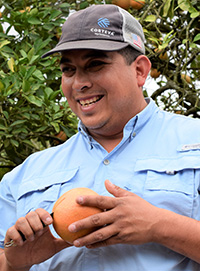 Consumers are often more likely to purchase a juicy, perfectly shaped orange or grapefruit than one that is undersized or oddly shaped. That fruit’s appearance — so important to its marketability — is determined long before it reaches grocery store shelves.
Consumers are often more likely to purchase a juicy, perfectly shaped orange or grapefruit than one that is undersized or oddly shaped. That fruit’s appearance — so important to its marketability — is determined long before it reaches grocery store shelves.
It all begins with healthy soils. To add value to a citrus grove, it's crucial for growers to first examine what’s going on with the foundation of their operation, then work their way up, says Zachary Lopez, Corteva Agriscience territory manager in South Texas.
Get to the root of your citrus trees' health
“What's going on underground impacts a tree’s roots, which ultimately impacts the overall plant health, which then affects fruit production and ultimately, grower profitability,” Lopez says. “If you have a healthier root system, you have a healthier plant, which ultimately gives you a larger fruit size and more crop uniformity.”
He adds, “We can all buy a bag of seed. We can all buy a tree, but if we don't better understand the health of our soil, we will not be able to optimize crop production.”
The first step, Lopez says, is soil testing to determine fertility needs, including the nutrients needed for optimum yield. A more in-depth look can verify other important soil characteristics, including available soil microbes and nematode populations.
Often, trees exhibit symptoms such as curled leaves that are incorrectly attributed to nutrition deficiencies or disease. Instead, the underlying issue may be a nematode infestation.
“To understand what's really happening, it's beneficial to take a holistic approach and look at the whole tree or the whole orchard from top to bottom,” Lopez says.
Know your nematicide needs
Lopez recommends soil testing for nematodes and fertility twice a year.
“Consistently testing for nematodes can help monitor year-over-year population numbers, ultimately improving control recommendations,” he says.
We can all buy a bag of seed. We can all buy a tree, but if we don't better understand the health of our soil, we will not be able to optimize crop production.”
Lopez suggests pulling samples during root expansion in the spring and fall when roots are growing.
“In South Texas, we have two root flushes each year,” he says. “Knowing when those root flushes occur gives us a great positioning point to use a nematicide to promote root health and soil health, which ultimately is going to result in larger, more uniform fruit and theoretically more profit in the grower's pocket.”
Lopez adds, “We have a plant that grows 365 days a year. Growers must ask themselves how soil health issues have the potential to influence profitability and performance.”
The More You Grow
Find expert insights on agronomics, crop protection, farm operations and more.